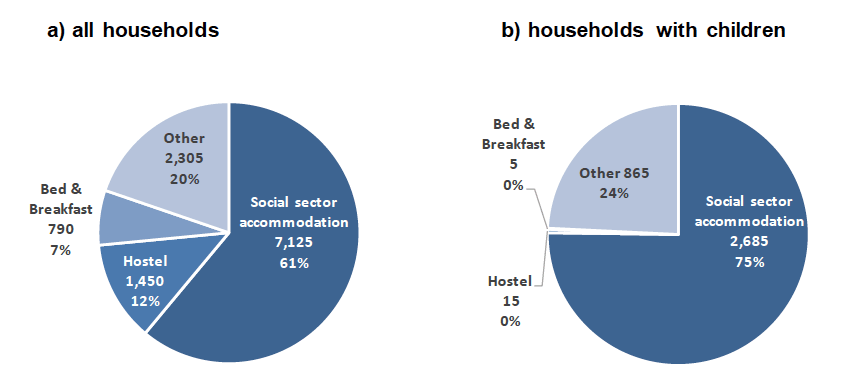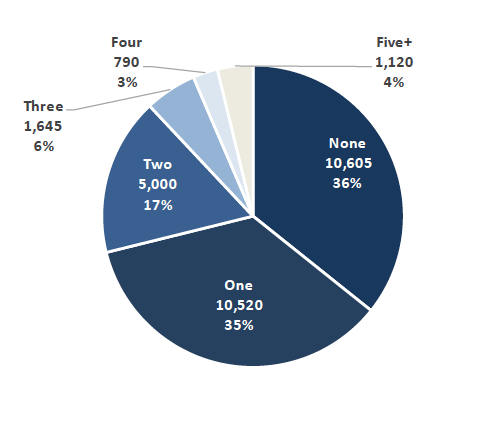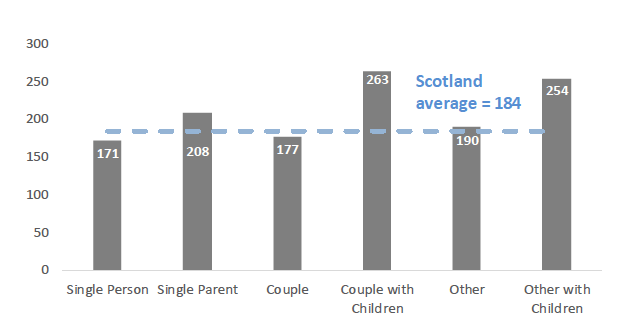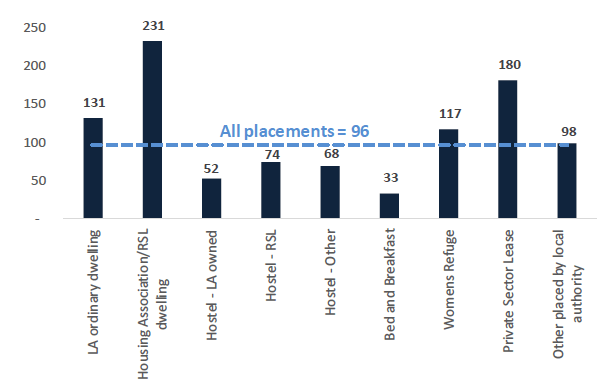Homelessness in Scotland: 2019 to 2020
This statistics bulletin provides information on homelessness in Scotland in the period from 1 April 2019 to 31 March 2020, alongside historical data.
This document is part of a collection
Temporary Accommodation
Key Points
- 61% of temporary accommodation used is in the social sector.
- 36% of homeless households had no temporary accommodation placement and 35% had one; 4% had 5 or more.
- Households spent 184 days in temporary accommodation on average.
- There were 4,595 cases of households not being offered temporary accommodation in 2019/20. Most of these were in Glasgow.
- There were 500 breaches of the unsuitable accommodation order. Most of these were in Edinburgh.
Sources of temporary accommodation data
Since 2002, local authorities have provided aggregate snapshot information relating to households in temporary accommodation. While this allows trends to be explored over time, understanding around individual placements and how these relate to assessed households is not possible from the snapshot data. Therefore, since 1st April 2016 placement level information on households in temporary accommodation has been provided to enable a more rounded picture of the use of temporary accommodation.
The snapshot data shows 11,665 households in temporary accommodation as at 31st March 2020. The placement level returns show that there were 12,074 temporary accommodation placements open at 31st March 2020 – 409 (4%) higher than the snapshot returns. Differences may be explained by the returns including different types of temporary accommodation and the placement level returns experiencing a lag in cases being closed.
Both of these figures show households in temporary accommodation at a point in time and, as such, will include those who have recently entered temporary accommodation as well as those who have been in temporary accommodation for a longer period of time (including prior to the reporting year).
Change to the reporting of temporary accommodation
Previously, reporting of temporary accommodation was based on households where there was a 'final' temporary accommodation placement within the reporting year, regardless of whether or not the homelessness case was closed. In reality this meant that, for example, a household which exited their second temporary accommodation placement in a reporting year, which would go on to enter a third temporary accommodation placement in a subsequent reporting year, would be considered as 'exiting' temporary accommodation. Given this will not reflect the true extent of temporary accommodation usage across the entirety of homelessness cases, figures relating to average time spent in temporary accommdation, number of placements etc. will be skewed. For this reason, a household is now only considered to have 'exited' temporary accommodation in a reporting year if their their homelessness case has closed.
How many people entered temporary accommodation? How many exited?
21,546 households entered a first temporary accommodation placement in 2019/20. To note, these will include households who made a homelessness application prior to 2019/20. 19,011 households exitied their final temporary accommodation placement in 2019/20.
These figures give a net difference of 2,535 more households entering temporary accommodation than exiting. This ties in with the increase in the number of households in temporary accommodation which can be seen in the snapshot figures, although the numbers will not match given the differences outlined.
What types of temporary accommodation are used?

The above chart shows that social sector accommodation is the majority of temporary accommodation used. Three quarters of households with children were in temporary accommodation as at 31st March 2020 compared to 61% overall. There are extremely low levels of use of hostels and bed & breakfast accommodation for households with children. (Tables 32 & 33).
Data from the placement level data collection can provide further insight in to the total use of temporary accommodation over the lifecycle of homelessness cases. However, it is difficult to make direct comparison with the snapshot data as different categories of temporary accommodation are used between the two returns.
There were 35,606 homelessness cases that closed in 2019/20, and from these a total of 39,400 temporary accommodation placements were taken up. 39% of temporary accommodation placements were in local authority ordinary dwellings or housing association/registered social landlord dwellings; 27% of placements were in hostel accommodation; and 22% of placements were in bed and breakfast accommodation. The higher proportions of hostel and bed and breakfast accommodation in the placement level returns (49% vs 19%) indicates that these types of temporary accommodation are more frequently used than the snapshot data suggests. However, this can be explained by the fact that the average duration for stays in these types of accommodation is much shorter - for example, 33 days in bed and breakfast compared to an average of 96 days for all temporary accommodation – and therefore they accound for a much smaller proportion of the overall use of temporary accommodation. (Tables 42 & 43)
Data on the number of placements and average length of time will help improve understanding of the ways in which different types of temporary accommodation are used.
How many temporary accommodation placements do households typically have?

There is variation in the number of placements between local authorities. Only 7% of homeless households in Shetland (5 out of 70) did not have any temporary accommodation placements, compared to 70% (450 out of 645) in Scottish Borders, although caution should be applied for local authorities with small numbers of households. In Edinburgh, 19% (485 out of 2,575) of homeless households had 5 placements or more (Table 37).
Use of temporary accommodation also varies by household type. Only 33% of 'single person' and 'couple with children' homeless households had no temporary accommodation placements in 2019/20. This compares to 50% of 'other' household types (households with multiple adults), 44% of 'other with children' and 41% of 'single parent' households. 'Couple' households were most likely to have higher number of placements, with 6% having 5 or more placements compared to 1% for 'other' households and 4% overall (Table 38).
How long do households spend in temporary accommodation?
The chart below shows that for homeless applications that closed in 2019/20 that took up temporary accommodation, households with children were likely to spend more time in temporary accommodation than those without. Note that total duration is calculated by summing the time a household spends in individual placements, excluding time between placements when a household is not in temporary accommodation. As a result the time a household spends in temporary accommodation may not be continuous.

Looking at average duration at a placement level shows duration varies by accommodation type with social sector temporary accommodation having higher durations than other types of accommodation. The average length of stay in housing association accommodation and local authority dwellings was 231 and 131 days, respecitvely, compared to 33 days in bed & breakfast accommodation. This confirms the expected shorter-term use of bed & breakfast and hostel accommodation.

How often do applicants refuse temporary accommodation?
A household can choose to refuse an offer of temporary accommodation made by the local authority. In 2019/20 there were 5,526 cases of households refusing offers of temporary accommodation. This was an increase of 1,299 (31%) compared to 2018/19. There was a particulay high increase in Glasgow, which increased by 95% from 978 to 1,906. (Table 44) To note, a household that has refused an offer of temporary accommodation may accept a subsequent offer.
How often do local authorities fail to provide temporary accommodation?
A local authority is required to indicate when they do not offer any temporary accommodation to a household and are therefore acting unlawfully. During 2019/20, there were 4,595[3] instances of households not being offered temporary accommodation (Table 45). The majority of these cases (3,385) were in Glasgow.
How often do local authorities breach unsuitable accommodation legislation?
A breach is encountered when a household with a pregnant member and/or child is in unsuitable temporary accommodation for more than 7 days. In 2019/20 there were 500 breaches; this compares to 645 breaches during 2018/19. The majority of breaches (375) during 2019/20 were in Edinburgh. (Table 46)
Contact
There is a problem
Thanks for your feedback